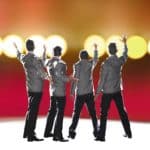
Since humans are both body and soul, oftentimes the spiritual changes we’d like to make are best accomplished with some physical changes as well. Maybe this Advent you’ll decide to get up earlier so as to be able to pray as the sun comes up. Maybe you’ll make some time for quiet prayer. The Church’s official prayer, the Sacred Liturgy, also helps us with physical signs pointing us toward the spiritual. We use darker colors to remind us the darkness awaiting the light of Christ’s birth. We brighten this darkness with the increasing light of the candles on our Advent wreaths. There is also an option regarding the direction of prayer at Mass that can help us focus our attention more on Christ’s coming and where we are going.
For most of the history of the Church, when the priest went to the altar to offer the Eucharist, he stood on the same side of the altar as the people. After the Second Vatican Council, the option was given that the priest could stand on either side of the altar. This new option had the advantage of allowing the people to see exactly what the priest was doing and to interact more with the priest. However, one of the unforeseen consequences was that it becomes easier to lose track of where we are going. Instead of seeing the church like a large boat in which we are all sailing forward toward a destination, it becomes easier to see the church more like an auditorium. The sanctuary can be mistaken for a stage with the people sitting out in the audience watching. This is the opposite of what the Council intended when calling for the “full, conscious, and active participation” of the faithful.
In recent years there has been a renewed interest in the traditional posture of the priest and the people on the same side of the altar and all facing the same direction together for the Eucharistic Prayer. This arrangement has the advantage of emphasizing a direction of movement in the liturgy. We are not stagnant and rigid, but flexible and moving forward. By all looking forward together, we physically represent the fact that, not only are we running forth to meet the Lord, but the Lord is also coming to meet us. We are formed into a great wedding party going out to meet the bridegroom at his coming. The word Advent means “coming.” It is therefore very fitting to consider the use of this ancient posture during Advent.
In the homily today, I mention some of my experiences of being on stage in my acting days. I still love theater, but I experience it mostly from the audience side these days. I recently went to see a production of the musical “Jersey Boys” about the Frankie Valli and the Four Seasons. As you might imagine, for most of the show the singers performed and the audience watched. However, at one key moment, all the actors turned around and performed facing the back wall of the stage with their backs to the audience. The thing is, you didn’t feel like the actors “had their backs to you.” Rather, because of the lighting and sound effects, they made you feel like you were on stage with the actors and that there was an audience out there beyond the stage that you couldn’t see.
As I said previously, the church is not an auditorium. Yet, this unique theatrical experience reminded me of an important truth about what happens when the priest and people face the same direction at Mass. Rather than the priest “turning his back on the people,” it creates a situation in which the people in the pews are invited to see themselves as “actors” along with the priest in the great theological drama taking place. Rather than a separation, it’s an invitation to greater unity. Both the priest and the people have important parts to play in the Mass, to pray that “my sacrifice and yours” might be acceptable. This is the “active participation” the Council envisioned. Oh, and that invisible audience? …there really is an invisible audience at Mass. All the angels and saints, and the entire heavenly marriage procession is coming to meet us. We might physically all be looking forward at the back wall of the church, but there’s much more unseen here than seen.
This traditional posture of the priest and people all facing forward together is sometimes referred to as facing ad orientem, literally “toward the East.” The Scripture tells us that Jesus ascended toward the East and promised to return just as the apostles saw him go. The East is thus symbolic of the return of Jesus in glory. It is also the direction of the rising sun, again drawing us to the hope of the dawn of the great “day” that will never end. In history we often tried to build our churches facing geographical East for just this reason, to give the spiritual a physical expression. Today, ad orientem is understood more often in a symbolic sense, with everyone facing the same direction even if it’s not always geographical East. I pray that this Advent might be a fruitful time to “reorient” our lives on the truth on the return of Jesus in glory. I pray that it might be a time for all of us to remember where we are going.
